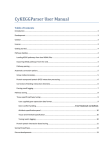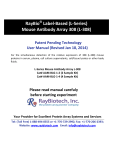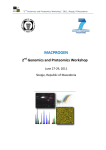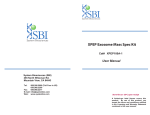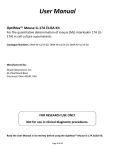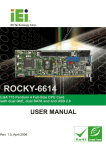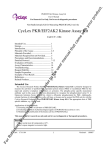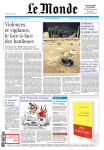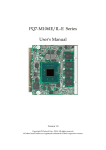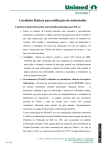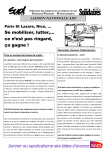Download Accelerating Scientific Discovery ÁPlease consider the
Transcript
Accelerating Scientific Discovery Human TLR Pathways qPCR Array Catalogue # GA-R204A, GA-R204B Description Toll-like receptors (TLRs) are single, membrane-spanning, non-catalytic receptors that activate immune cell responses upon microbes invasion. This Human TLR Pathways Array is designed to profile the expression of 88 genes for the receptors in the TLR family as well as the adapter proteins and kinases that mediate TLR signaling. Our PCR Array plates are pre-coated with EvaGreen-optimized primer assays for a thoroughly researched panel of relevant, pathway- or disease-focused genes. Our unique high-quality primer design and master mix formulation enable the PCR Array to amplify 96 different gene-specific products simultaneously under uniform cycling conditions. All primer sets designed by our expertise scientists are able to amplify the alternative splice variants of corresponding target genes. A few additional house-keeping genes are used as positive controls. Features High Sensitivity: cDNA made from as little as 1 ng (or as much as 5 µg) of total RNA per array plate provides greater than 85 percent present call rates. High Reproducibility: the system has replicate correlation coefficients > 0.99, which means that experimental samples can be reliably compared across plates and runs. High Specificity: the combination of EvaGreen primers and 2x Elite qPCR MasterMix guarantees a single product of the predicted size from every reaction without secondary products such as primer dimers. Controls are also included for monitoring genomic DNA contamination, RNA quality, and general PCR performance. Easy to Use: simple experiment workflow and easy-to-use Excel-based template for data analysis. The analysis is based on the ΔΔCt method with normalization of the raw data to either housekeeping genes or an external RNA control. This PCR Array is compatible with, but not limited to, all ABI, Bio-Rad, Eppendorf, QIAGEN, Roche, and Stratagene instruments. TM Kit Components TM 2x Elite qPCR MasterMix (HotStart Taq, dNTP, EvaGreen Dye; ROX Passive Reference Dye included for format B) Adhesive films (1 piece each plate) Manual and PCR Data Analysis Tool (one CD included) 96-well plate array (see the table below for the genes included) A1 A2 A3 A4 A5 A6 A7 A8 A9 A10 A11 A12 BTK CASP8 CCL2 CD14 CD80 CD86 CHUK CLEC4E CSF2 CSF3 CXCL10 EIF2AK2 B1 B2 B3 B4 B5 B6 B7 B8 B9 B10 B11 B12 ELK1 FADD FOS HMGB1 HRAS HSPA1A HSPD1 IFNA1 IFNB1 IFNG IKBKB IL10 C1 C2 C3 C4 C5 C6 C7 C8 C9 C10 C11 C12 IL12A IL1A IL1B IL2 IL6 IL8 IRAK1 IRAK2 IRF1 IRF3 JUN LTA D1 D2 D3 D4 D5 D6 D7 D8 D9 D10 D11 D12 CD180 LY86 LY96 MAP2K3 MAP2K4 MAP3K1 MAP3K7 TAB1 MAP4K4 MAPK8 MAPK8IP3 MYD88 E1 NFKB1 E2 NFKB2 E3 NFKBIA E4 NFKBIL1 E5 NFRKB E6 NR2C2 E7 PELI1 E8 PPARA E9 PRKRA E10 PTGS2 E11 REL E12 RELA F1 RIPK2 F2 SARM1 F3 SIGIRR F4 ECSIT F5 TBK1 F6 TICAM2 F7 TIRAP F8 TLR1 F9 TLR10 F10 TLR2 F11 TLR3 F12 TLR4 G1 G2 G3 G4 G5 G6 G7 G8 G9 G10 G11 G12 TLR5 TLR6 TLR7 TLR8 TLR9 TNF TNFRSF1A TOLLIP TRAF6 TICAM1 UBE2N UBE2V1 H1 H2 H3 H4 H5 H6 H7 H10 H11 H12 RIPK3 RGS2 RPL13A B2M HGD1 HGD2 GAPDH GAPDH ACTB ACTB TUBA1B HPRT1 Please consider the environment before printing. Tel: 1-240-683-5851 Fax: 1-240-683-5852 [email protected] www.eEnzyme.com Page 1 Accelerating Scientific Discovery Order Information We have two formats of 2x Elite TM qPCR MasterMix for different type of the realtime thermal cyclers. Format A is suitable for use with the real-time thermal cyclers that do not require a reference dye: Bio-Rad models CFX96, CFX384; Bio-Rad/MJ Research models Chromo4, DNA Engine Bio-Rad models iCycler, iQ5, MyiQ, MyiQ2, Opticon 2; Roche LightCycler 480 (96-well). Human TLR Pathways qPCR Array trial size (Cat# GA-R204A1) Human TLR Pathways qPCR Array (Cat# GA-R204A) 96-Well Plate Containing Dried Assays (Part# R204-120) 2 plates 12 plates Adhesive Film (Part# GA-005) 2 pieces 12 pieces 2 x 1.25 ml 12x 1.25 ml qPCR Array Format A TM 2x Elite qPCR MasterMix (HotStart Taq, dNTP, EvaGreen Dye) (Part# GA-135) Format B is suitable for use with the following real-time thermal cyclers: Applied Biosystems models 5700, 7300, 7500 (Standard and Fast), 7700, 7900HT (Standard and Fast), StepOnePlus, ViiA7 (Standard and Fast); Eppendorf Mastercycler ep realplex models 2, 2S, 4, 4S; Stratagene models Mx3000P, Mx3005P, Mx4000; Takara TP-800. Human TLR Pathways qPCR Array trial size (Cat# GA-R204B1) Human TLR Pathways qPCR Array (Cat# GA-R204B) 96-Well Plate Containing Dried Assays (Part# R204-120) 2 plates 12 plates Adhesive Film (Part# GA-005) 2 pieces 12 pieces 2 x 1.25 ml 12x 1.25 ml qPCR Array Format B TM 2x Elite qPCR MasterMix (HotStart Taq, dNTP, EvaGreen Dye, ROX Passive Reference Dye) (Part# GA-245) Storage o Keep in freezer (-20 C) and avoid exposure to light. Materials Required But Not Included The Reverse transcription reagents for making the cDNA from your prepared total RNA are not included in the array kit (Protocol and reagents from Invitrogen and Qiagen for reverse transcription have been tested and worked well along with this kit). High-quality, nuclease-free water. Do not use DEPC-treated water Low EDTA–TE buffer (0.1 mM EDTA) Important Notes before Use 1. Please read through this entire protocol before beginning your experiment. TM 2. The use of eEnzyme 2x Elite qPCR MastMix (included) is critical for obtaining the most accurate results from the PCR Array. Please consider the environment before printing. Tel: 1-240-683-5851 Fax: 1-240-683-5852 [email protected] www.eEnzyme.com Page 2 Accelerating Scientific Discovery 3. Make sure you have the correct PCR array plate format for your realtime PCR instrument to avoid damage. 4. The accuracy and precision of pipetting determines the consistency of the results. Make sure that all the micropipettors used are calibrated and not to introduce any bubbles into the wells of the PCR Array. 5. DEPC treated H2O should NOT be used. Use high-quality, nuclease-free H2O. Check with the supplier if not sure whether your RNase, DNase-free water has been treated with DEPC. 6. Exam the quality of your sample RNA before starting the experiment. TM 7. If precipitates are present in eEnzyme 2x Elite qPCR MastMix tubes, please contact a technical application scientist at 1-800-919-0755 or [email protected]. 8. Regarding the concern of genomic DNA contamination: our arrays are designed to skip at least one intron so that traces of contaminated genomic DNA in the sample, if there is any, will not be amplified. In addition, each pair of o primers are designed to have 60 C±1 annealing temperature, which guarantees that large-sized genomic DNA, if any, cannot be amplified. Workflow and Protocols 1. Make cDNA from your sample RNA. (refer to your reverse transcription kit manual, not included in the array kit.) TM 2. Thaw 2x Elite qPCR MasterMix on ice, vortex and briefly spin down. 3. Mix all following components in a tray for multi-channel pipetting. Carefully pipette precise 25 µl reaction mix to each of the 96 wells. Change pipet tips following each addition to avoid any cross-contamination. 2x Elite TM qPCR MasterMix 1250 µl Diluted cDNA 100 µl nuclease-free H2O 1150 µl Total Volume 2500 µl o Note: save the remainder of the cDNA synthesis reaction and store at -20 C for possible RNA quality analysis in later troubleshooting step. 4. Loading the PCR arrays: Please select your PCR Array Format for loading instruction. 1.1 Carefully remove the PCR Array from its sealed bag. 1.2 Dispense Experimental Cocktail to PCR Array Loading Reservoir to assist in loading (optional). 1.3 Add 25 µl of the Experimental cocktail to each well of the PCR Array, preferably from a reservoir with an eight- or twelve-channel pipettor. 5. Performing realtime PCR detection: Attention: Users of Bio-Rad and Eppendorf Realtime instruments - prior to initiating the run, make sure your instrument has been calibrated for using clear sticky film. Note: follow the manufacturer’s instruction for the proper operation and maintenance of your realtime instrument. 5.1. Carefully and tightly seal the PCR Array with the optical thin adhesive film. o 5.2. Centrifuge the plate for 1 full minute at 4 C at 1000g to remove bubbles. Visually inspect the plate from underneath of the plate to ensure no bubbles are present in each well. 5.3. Place the plate on ice while setting up the PCR cycler program below. 5.4. Place the plate in your realtime thermal cycler if recommended by your instrument’s user manual, use a compression pad with the optical film-sealed plate formats. o Note: PCR Arrays containing experimental cocktail may be store at -20 C wrapped in aluminum foil for up to one week until ready to run. 5.5. Enter and run the appropriate program for your realtime instrument. We provide a file to help customs easy to load software for both ABI and Bio-Rad realtime PCR instruments. Please consider the environment before printing. Tel: 1-240-683-5851 Fax: 1-240-683-5852 [email protected] www.eEnzyme.com Page 3 Accelerating Scientific Discovery Use a Two-step cycling program for the following instrumentation: Real Time PCR Instruments ABI:5700, 7000, 7300, 7500, 7700,7900HT StepOnePlus Bio-Rad: icycler, IQ5, MyiQ, MyiQ2, CFX96, CF384. Eplpendorf: Mastercycler ep realplex 2, 2s, 4, 4S Stratagene: Mx3000p, Mx3005p, Mx4000p Cycles Duration Temperature 1 5 min 95 C 40 15 seconds 95 C 1 min 58 C o o o o Attention: Bio-Rad CFx96 &CF384 users- adjust the ramp rate to 1 C/sec. 5.6. Calculate the threshold cycle (Ct) for each well using the instrument’s software. Note: for Roche Light Cycler 480 Users, there are two options available to analyze your data. Use the second derivate max setting and there is no need to set a threshold. i. To define the Baseline. Choose the Automated Baseline option if your instrument has the Adaptive Baseline Function (check with instrument manual or manufacturer if unsure). If it does not have the adaptive baseline function, you will need to set the baseline manually. Use the Linear View of the amplification plots to determine the earliest visible amplification. Set the instrument to use the readings from cycle number two (2) through two (2) cycles before the earliest visible amplification, but no more than cycle 15. The earliest amplification usually will be visible between cycles 14 and 18. ii. Manually define the threshold value by using the log view of the amplification plots and place it above the background signal but within the lower one-third to lower one half of the linear phase of the amplification plot. Important: ensure that the thresholds are the same across all PCR Array runs in the same analysis. The absolute position of the threshold is less critical than its consistent position across arrays. When the quality of the RNA sample adequately controlled, the cycling program executed properly, and the ppc thresholds defined correctly, the value of Ct should be 20±2 cross all of your arrays or samples. iii. Export the resulting threshold cycle values for all wells to a blank Excel spreadsheet for use with the PCR Array Data Analysis Template Excel. 6. Recommended Quality Control: Dissociation (Melting) Curve For instrument specific melt curve analysis settings, please refer to the corresponding instrument Setup Guide. o Note: If you decide not to obtain the dissociation curve immediately, save the plates in aluminum foil at -20 C as is, in case you need to do this operation at a later time for troubleshooting. When ready, simply warm the plate to room temperature, place it into your realtime instrument, and run the melting program described above. i. Be sure to visually inspect the plate after the run for any sign of evaporation from any of the wells. If evaporation is observed, make a note of which wells so that you may qualify your data analysis appropriately. ii. Do not open any previously run and stored PCR Array plate. Removing the adhesive film to see if PCR product is evaporated during PCR process. iii. Run a melting curve program immediately after the above cycling program, and generate a first derivative dissociation curve for each well in the entire plate using your instrument’s software. No o more than one peak should appear in each reaction at temperatures greater than 80 C. If your o instrument does not have a default melting curve program, run the following program instead: 95 C o o o o 1min. 65 C 2min (Optics off); 65 C to 95 C at 2 C/min (Optics ON). Please consider the environment before printing. Tel: 1-240-683-5851 Fax: 1-240-683-5852 [email protected] www.eEnzyme.com Page 4 Accelerating Scientific Discovery Gene Information Position GeneBank A1 A2 Symbol Name BTK CASP8 Bruton agammaglobulinemia tyrosine kinase Caspase 8, apoptosis-related cysteine peptidase CCL2 CD14 Chemokine (C-C motif) ligand 2 CD14 molecule CD80 CD86 CD80 molecule CD86 molecule CHUK CLEC4E CSF2 CSF3 Conserved helix-loop-helix ubiquitous kinase C-type lectin domain family 4, member E Colony stimulating factor 2 (granulocyte-macrophage) Colony stimulating factor 3 (granulocyte) CXCL10 EIF2AK2 Chemokine (C-X-C motif) ligand 10 Eukaryotic translation initiation factor 2-alpha kinase 2 ELK1 ELK1, member of ETS oncogene family FADD FOS HMGB1 HRAS Fas (TNFRSF6)-associated via death domain FBJ murine osteosarcoma viral oncogene homolog High mobility group box 1 V-Ha-ras Harvey rat sarcoma viral oncogene homolog HSPA1A HSPD1 Heat shock 70kDa protein 1A Heat shock 60kDa protein 1 (chaperonin) IFNA1 IFNB1 IFNG IKBKB Interferon, alpha 1 Interferon, beta 1, fibroblast Interferon, gamma Inhibitor of kappa light polypeptide gene enhancer in B-cells, kinase beta B12 C1 NM_000061.2 NM_001228.4 NM_001080125.1 NM_001080124.1 NM_033358.3 NM_033356.3 NM_033355.3 NM_002982.3 NM_000591.3 NM_001040021.2 NM_001174105.1 NM_001174104.1 NM_005191.3 NM_006889.4 NM_175862.4 NM_001206925.1 NM_001206924.1 NM_176892.1 NM_001278.3 NM_014358.2 NM_000758.3 NM_000759.3 NM_001178147.1 NM_172220.2 NM_172219.2 NM_001565.3 NM_002759.3 NM_001135652.2 NM_001135651.2 NM_005229.4 NM_001114123.2 NM_001257168.1 NM_003824.3 NM_005252.3 NM_002128.4 NM_005343.2 NM_176795.3 NM_001130442.1 NM_005345.5 NM_002156.4 NM_199440.1 NM_024013.2 NM_002176.2 NM_000619.2 NM_001556.2 NM_001190720.2 NM_001242778.1 NM_000572.2 NM_000882.3 IL10 IL12A C2 C3 C4 NM_000575.3 NM_000576.2 NM_000586.3 IL1A IL1B IL2 Interleukin 10 Interleukin 12A (natural killer cell stimulatory factor 1, cytotoxic lymphocyte maturation factor 1, p35) Interleukin 1, alpha Interleukin 1, beta Interleukin 2 A3 A4 A5 A6 A7 A8 A9 A10 A11 A12 B1 B2 B3 B4 B5 B6 B7 B8 B9 B10 B11 Please consider the environment before printing. Tel: 1-240-683-5851 Fax: 1-240-683-5852 [email protected] www.eEnzyme.com Page 5 Accelerating Scientific Discovery C5 C6 C7 C8 C9 C10 C11 C12 D1 D2 D3 D4 D5 D6 D7 D8 D9 D10 D11 D12 E1 E2 E3 E4 E5 NM_000600.3 NM_000584.3 NM_001569.3 NM_001025243.1 NM_001025242.1 NM_001570.3 NM_002198.2 NM_001571.5 NM_001197128.1 NM_001197127.1 NM_001197125.1 NM_001197126.1 NM_001197124.1 NM_001197123.1 NM_001197122.1 NM_002228.3 NM_000595.3 NM_001159740.2 NM_005582.2 NM_004271.3 NM_015364.4 NM_001195797.1 NM_002756.4 NM_145109.2 NM_003010.2 NM_005921.1 NM_003188.3 NM_145333.2 NM_145332.2 NM_145331.2 NM_006116.2 NM_153497.2 NM_004834.4 NM_145687.3 NM_145686.3 NM_001242560.1 NM_001242559.1 NM_002750.2 NM_139049.1 NM_139047.1 NM_139046.1 NM_015133.3 NM_001040439.1 NM_002468.4 NM_001172568.1 NM_001172569.1 NM_001172567.1 NM_001172566.1 NM_003998.3 NM_001165412.1 NM_002502.4 NM_001077494.2 NM_001261403.1 NM_020529.2 NM_005007.3 NM_001144963.1 NM_001144962.1 NM_001144961.1 NM_006165.3 NM_001143835.1 IL6 IL8 IRAK1 Interleukin 6 (interferon, beta 2) Interleukin 8 Interleukin-1 receptor-associated kinase 1 IRAK2 IRF1 IRF3 Interleukin-1 receptor-associated kinase 2 Interferon regulatory factor 1 Interferon regulatory factor 3 JUN LTA Jun proto-oncogene Lymphotoxin alpha (TNF superfamily, member 1) CD180 LY86 LY96 CD180 molecule Lymphocyte antigen 86 Lymphocyte antigen 96 MAP2K3 Mitogen-activated protein kinase kinase 3 MAP2K4 MAP3K1 MAP3K7 Mitogen-activated protein kinase kinase 4 Mitogen-activated protein kinase kinase kinase 1, E3 ubiquitin protein ligase Mitogen-activated protein kinase kinase kinase 7 TAB1 TGF-beta activated kinase 1/MAP3K7 binding protein 1 MAP4K4 Mitogen-activated protein kinase kinase kinase kinase 4 MAPK8 Mitogen-activated protein kinase 8 MAPK8IP3 Mitogen-activated protein kinase 8 interacting protein 3 MYD88 Myeloid differentiation primary response gene (88) NFKB1 Nuclear factor of kappa light polypeptide gene enhancer in B-cells 1 NFKB2 Nuclear factor of kappa light polypeptide gene enhancer in B-cells 2 (p49/p100) NFKBIA NFKBIL1 Nuclear factor of kappa light polypeptide gene enhancer in B-cells inhibitor, alpha Nuclear factor of kappa light polypeptide gene enhancer in B-cells inhibitor-like 1 NFRKB Nuclear factor related to kappaB binding protein Please consider the environment before printing. Tel: 1-240-683-5851 Fax: 1-240-683-5852 [email protected] www.eEnzyme.com Page 6 Accelerating Scientific Discovery E6 E7 E8 E9 E10 E11 E12 F1 F2 F3 F4 F5 F6 F7 F8 (F8) F9 F10 F11 F12 G1 G2 G3 G4 G5 G6 G7 G8 G9 G10 G11 G12 NM_003298.3 NM_020651.3 NM_005036.4 NM_001001928.2 NM_003690.4 NM_001139518.1 NM_001139517.1 NM_000963.2 NM_002908.2 NM_021975.3 NM_001145138.1 NM_001243985.1 NM_001243984.1 NM_003821.5 NM_015077.2 NM_021805.2 NM_001135054.1 NM_001135053.1 NM_016581.4 NM_001142465.2 NM_001142464.2 NM_001243204.1 NM_013254.3 NM_021649.6 NM_181836.5 NM_001164469.2 NM_001164468.2 NM_001039661.1 NM_148910.2 NM_003263.3 NR2C2 PELI1 PPARA Nuclear receptor subfamily 2, group C, member 2 Pellino E3 ubiquitin protein ligase 1 Peroxisome proliferator-activated receptor alpha PRKRA Protein kinase, interferon-inducible double stranded RNA dependent activator PTGS2 REL RELA Prostaglandin-endoperoxide synthase 2 (prostaglandin G/H synthase and cyclooxygenase) V-rel reticuloendotheliosis viral oncogene homolog (avian) V-rel reticuloendotheliosis viral oncogene homolog A (avian) RIPK2 SARM1 SIGIRR Receptor-interacting serine-threonine kinase 2 Sterile alpha and TIR motif containing 1 Single immunoglobulin and toll-interleukin 1 receptor (TIR) domain ECSIT ECSIT homolog (Drosophila) TBK1 TICAM2 TANK-binding kinase 1 Toll-like receptor adaptor molecule 2 TIRAP Toll-interleukin 1 receptor (TIR) domain containing adaptor protein TLR1 Toll-like receptor 1 NM_030956.3 NM_001017388.2 NM_001195108.1 NM_001195107.1 NM_001195106.1 NM_003264.3 NM_003265.2 NM_138554.4 NM_003266.3 NM_138557.2 NM_003268.5 NM_006068.4 NM_016562.3 NM_138636.4 NM_017442.3 NM_000594.3 NM_001065.3 NM_019009.3 NM_004620.3 NM_145803.2 NM_182919.3 NM_003348.3 NM_021988.5 NM_199129.2 NM_199203.2 NM_199144.2 TLR10 Toll-like receptor 10 TLR2 TLR3 TLR4 Toll-like receptor 2 Toll-like receptor 3 Toll-like receptor 4 TLR5 TLR6 TLR7 TLR8 TLR9 TNF TNFRSF1A TOLLIP TRAF6 Toll-like receptor 5 Toll-like receptor 6 Toll-like receptor 7 Toll-like receptor 8 Toll-like receptor 9 Tumor necrosis factor Tumor necrosis factor receptor superfamily, member 1A Toll interacting protein TNF receptor-associated factor 6, E3 ubiquitin protein ligase TICAM1 UBE2N UBE2V1 Toll-like receptor adaptor molecule 1 Ubiquitin-conjugating enzyme E2N Ubiquitin-conjugating enzyme E2 variant 1 Please consider the environment before printing. Tel: 1-240-683-5851 Fax: 1-240-683-5852 [email protected] www.eEnzyme.com Page 7 Accelerating Scientific Discovery H1 H2 H3 H4 H5 H6 H7 H8 H9 H10 H11 H12 NM_001032288.2 NM_022442.5 NM_001162505.1 NM_001257395.1 NM_001257394.1 NM_001257393.1 NM_001257399.1 NM_001257398.1 NM_001257397.1 NM_001257396.1 NM_006871.3 NM_002923.3 NM_012423.3 NM_001270491.1 NM_004048.2 BSG-0001 BSG-0002 NM_002046.4 NM_001256799.1 NM_002046.4 NM_001256799.1 NM_001101.3 NM_001101.3 NM_006082.2 NM_000194.2 RIPK3 RGS2 RPL13A Receptor-interacting serine-threonine kinase 3 Regulator of G-protein signaling 2, 24kDa Ribosomal protein L13a B2M HGD1 HGD2 GAPDH Beta-2-microglobulin Human Genomic DNA Contamination Human Genomic DNA Contamination Glyceraldehyde-3-phosphate dehydrogenase GAPDH(1) Glyceraldehyde-3-phosphate dehydrogenase ACTB ACTB(1) Tuba1b HPRT1 Actin, beta Actin, beta Homo sapiens tubulin, alpha 1b (TUBA1B) Hypoxanthine phosphoribosyltransferase 1 Please consider the environment before printing. Tel: 1-240-683-5851 Fax: 1-240-683-5852 [email protected] www.eEnzyme.com Page 8








